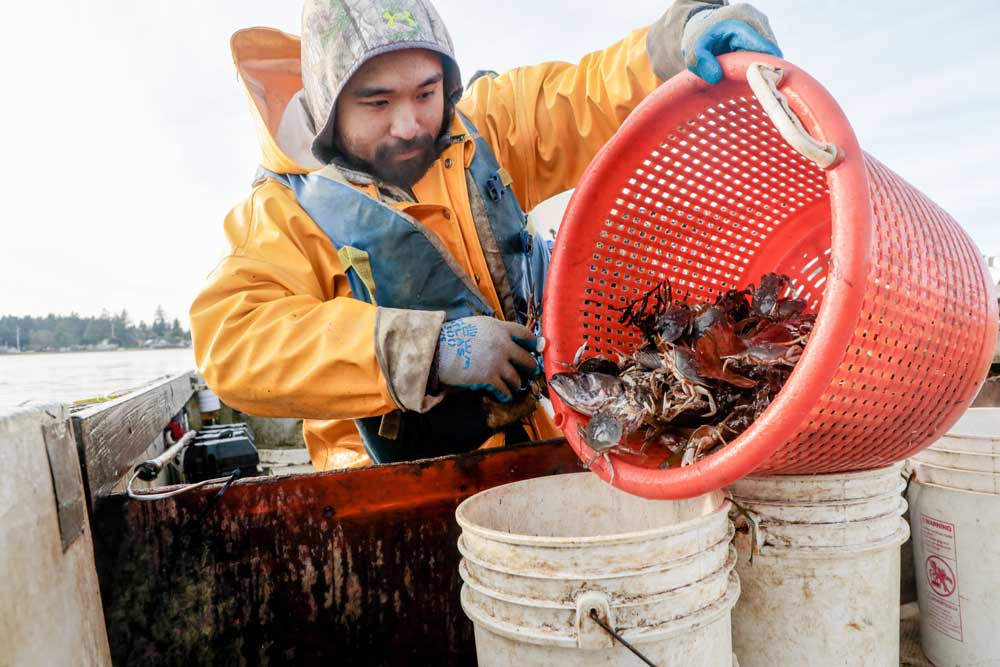Top trappers: Willapa Bay crew leads front-line fight against green crab
Published 11:48 am Monday, December 18, 2023

- Niko Hora unloads approximately 300 green crab caught during a trip last weekend.
NAHCOTTA — In the dead of December the war against the invasive European green crab in Willapa Bay marches on.
Trending
Leading the fight is a small crew of dedicated locals, including Warren Cowell, Niko Hora and Carlos Morales, now responsible for removing more than 120,000 crabs from bay waters since the beginning of the year — accounting for more than 50% of Washington’s total trapping efforts statewide.
Dubbed “the world’s worst invasive species” by the Washington Department of Fish and Wildlife, European green crab (EGC) are a notoriously formidable foe, each capable of consuming up to 40 clams a day and seriously threatening Washington’s shellfish and aquaculture industries.
Lots at stake
At stake are the livelihoods of Willapa Bay shellfish farmers, who have reported a surge of the invasive crab in recent years. The shellfish industry is among Pacific County’s biggest moneymakers and employers.
“We’ve been trapping here for two years in February,” said Cowell, 60, as he climbed into a Boston whaler skiff last Saturday afternoon along with Niko Hora, a coworker he affectionately dubbed “the most badass green crab killer in the state,” and Cowell’s three dogs: Willi Pa, Luna and Red.
‘We’re the ones really going after it, because someone has to set the pace. I’ve made a good living on this bay, I’ve spent my whole life out here. This is my way of paying it forward.’
Warren Cowell, Willapa crab trapper and shellfish farmer
“We get a couple hundred every time we go here,” Cowell continued as he pumped 10 gallons of fuel, enough to check a couple dozen crab traps strategically placed around the perimeter of the Port of Peninsula.
The traps, deployed two days earlier, were the latest set to be checked. December is considered a slow time to catch EGC, following a peak in the fall.
“Around October-November we were getting 3,000 [green crab] a day,” Cowell said, adding that they run up to 180 traps requiring all hands on deck. “We’re up to 120,000 green crab for the year, personally.”
According to WDFW, approximately 230,000 EGC have been removed from Washington waters by licensed trappers in 2023, with Cowell’s crew accounting for more than half. Roughly 160,000 have been removed from Willapa Bay overall this year, by far the highest total in the state, followed by 60,000 in Grays Harbor.
After they’re caught, the EGC are counted and sorted by sex, with gravid (pregnant) females separated from the males. Any bycatch, including Dungeness, red rock or spider crabs, are immediately released. The kept green crab are then transported to the WDFW field station along Sandridge Road in Nahcotta, where they’re humanely euthanized via freezing, with some to be later analyzed by biologists.
Growing concern
Cowell first saw green crab in Willapa Bay about 15 years ago.
“We would just spot them here and there. Then the amount of clams we were getting cratered, just went down for everybody,” he said. “We were looking for reasons why and we heard they were getting more green crab. Then the governor declared it an emergency in 2020, so I went out and bought some of my own traps. We caught 30-40 green crab per trap on the first day, in February 2020.”
Since then, Cowell has obtained an invasive species permit to trap the crab legally and hired two employees. Cowell pays the trappers by the hour, and is later reimbursed by WDFW, which also covers expenses for fuel, bait and traps.
“We’re the ones really going after it, because someone has to set the pace. I’ve made a good living on this bay, I’ve spent my whole life out here. This is my way of paying it forward,” Cowell said.
One hindrance, however, has been the time it takes to get repaid.
“It takes about two months to get reimbursed, so right now I’m out about $50,000. It’s a lot of money for me to float,” Cowell said.
Under the direction of Gov. Jay Inslee’s Emergency Order, WDFW now leads an Incident Command System (ICS) to coordinate agencies, tribes and partners working to control EGC. These entities removed more than 285,000 of the invasive crabs from Washington waters in 2022, most from Willapa Bay and the Lummi Nation’s Sea Pond.
In June 2023, WDFW launched a new online European Green Crab Hub (wdfw-egc-hub-wdfw.hub.arcgis.com) to support the coordination of ongoing emergency measures and provide public information about the management of this invasive species. This coincides with the continued ramp-up of trapping to control these harmful shore crabs in Washington waters.
WDFW’s Aquatic Invasive Species (AIS) unit anticipates deploying more than 25 staff and 1,000 traps during the 2023 field season, along with other equipment and resources.









